Day 52-56 – February 25-28
Santiago, Chile to Los Angeles, Chile to Osorno, Chile
February 25-26
We arrived in Santiago on Wednesday, February 24 and had planned to stay for one day but ended up staying for two. Our choice of one extra day allowed us to experience the 7th largest earthquake in recorded history, which struck in the very early hours of Saturday, the 27th. Prior to the earthquake adventure, we had some time to experience Santiago:
On Thursday and Friday we toured the city, obtaining parts, fixing my video camera, and visiting the BMW dealer. At the dealership, we saw a device that protects your head from whiplash in the event you are thrown from your motorcycle:

We hung out with several cops during the day – here is the commander of the motorcycle police in Santiago, mock-arresting Roger.
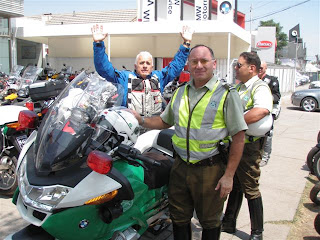
I was able to pick up all the equipment I needed to repair various items: my POV camera, the sole of my motorcycle boot, and various nuts and bolts that had fallen off my bike.
We toured the city, which was primarily filled with low-rise buildings. . .


. . .with a smattering of high rises in the downtown area. This building is next to our hotel in the center of the city (note that the road through the center of the city is a parkway with 5 lanes in each direction, which comes in handy during earthquakes):
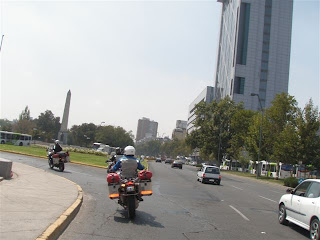
The city center had shops designed for nearly everyone—this one would be a particular favorite of my daughters and anyone with a shoe fetish:

EARTHQUAKE
February 27
We went to bed on Friday night with a plan to wake up early and beat the traffic – meeting for breakfast at 7:00 a.m. and “clutches out” by 7:30 a.m.
I slept fitfully and at 3:30 a.m. awoke to a creaking noise. I tried to get out of bed but was unable to stand and subsequently fell and conked my head on a piece of furniture. I then realized that we were experiencing a quake. We were on the 20th floor of the Crown Plaza hotel, a new modern hotel in downtown Santiago. (I previously experienced another earthquake at a downtown hotel in Tokyo and was rather embarrassed when I dashed into the hall in my bathrobe, only to discover that no one else was slightly concerned.) I briefly considered leaving the hotel but remembered how foolish I felt in Tokyo.
I looked out over the city and the lights were still on and dazzling. But then suddenly all of the lights of the city went out at once.
The oscillation of the building had an abnormal feeling, not like the mostly steady motion you feel in a sailboat in rough seas. This motion was jerky and non-rhythmic, erratic and discontinuous. I was amazed that this largely concrete building was able to survive the whiplashing effect compounded by the building’s height.
Vincent banged on my door, dressed ready to ride, and said we should head downstairs immediately – all three of us initially said no, but we eventually joined him downstairs. This required running down twenty stories in the concrete inner stairway. (The electricity was off and of course the elevators weren’t working—although I cannot imagine anyone would be stupid enough to actually take the elevators).
As we got nearer to the ground floor, cracks in the walls and separation in the concrete floors became visible:
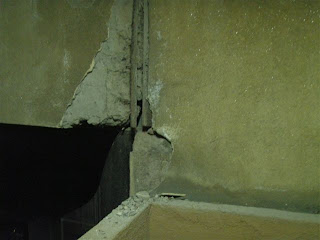
We passed through areas filled with shattered glass. The hotel attendants were coaxing everyone to move quickly past these hazards:

As we exited the hotel, the street scene before us was a mix of revelers and disgusted hotel guests. . .
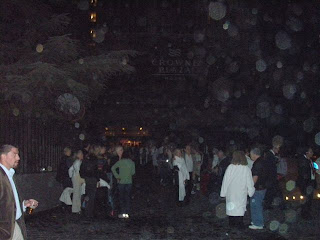
. . .including this man in his long underwear:
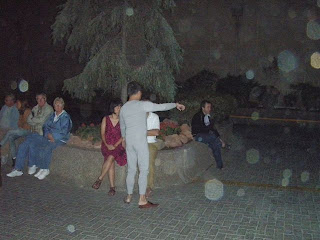
The hotel staff was extraordinary—they raced around handing out robes for those caught unawares and scantily-clad:
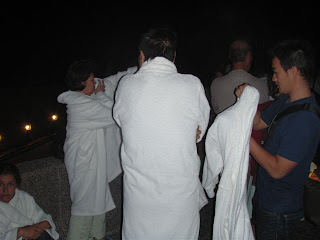
By chance, I talked with a biologist who was knowledgeable about earthquakes and he estimated that we had just experienced about a 6 on the Richter scale. He mentioned that the aftershocks were always significantly less than the initial shock, generally 3-10 times less in absolute severity.
So I decided to return my room and headed through the lobby where, as you would expect, informality was evident:
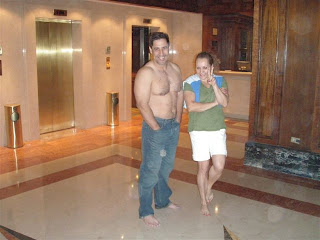
Vincent was napping on a couch . . .
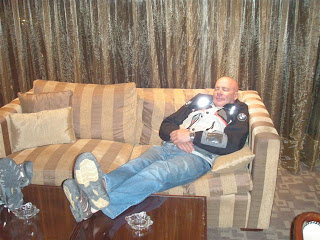
. . . and a variety of others were hiding their scantily-clad bodies under hotel robes.

I trudged up the twenty floors and arrived in my room. I hung the hair dryer from the bathroom sink to watch it sway during the aftershocks – during one aftershock, the arc of the sway reached about five inches:


This leads me to believe that the arc of the sway during the main earthquake would probably have been around two feet.
We got our stuff together, carried it down the twenty floors and headed out of town. We saw very little damage in Santiago itself, although we didn’t go into the areas of old construction where we subsequently heard most of the damage had occurred.
As we drove through downtown, things looked relatively normal, but as we got a bit further out of town we ran into large traffic jams – some were miles long:

To get away from the highway and the traffic jams, we went over land and took dirt roads into the mountains and away from the cities. We were fortunate that our GPS systems contain full maps of Chile and show the secondary roads as well as primary ones.
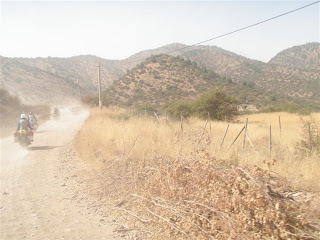
The road was extremely dusty, and large boulders were frequently in our path, obscured by the dust we kicked up.
As we neared Los Angeles (115 kilometers southeast of Concepcion), there were mile-long lines for gasoline. . .
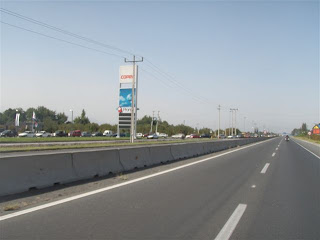
. . .downed bridges. . .
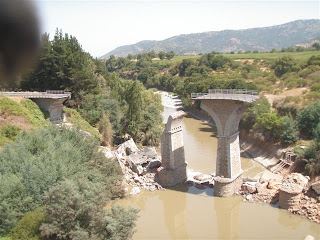

. . .heaving roads. . .
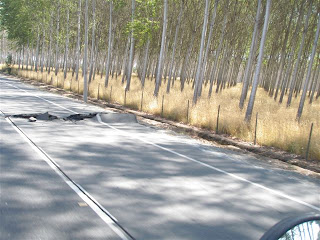
. . .and a spot where one lane of the road had disappeared into a ten-foot trench.
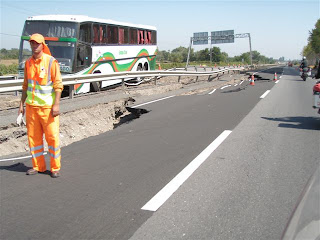
We passed a large distribution center that was ablaze, with no fire department in sight:
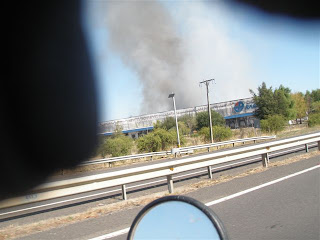
Most of the hotels in the small town of Los Angeles had been damaged and were not open for business. We found a place to stay that looked like it may have been used as a bordello. We scrounged some food at a convenience store, buying all of their canned sardines and two bottles of wine, and had an excellent dinner.

Sunday, February 28
The next morning, we got up early and passed a huge line of trucks waiting for fuel:
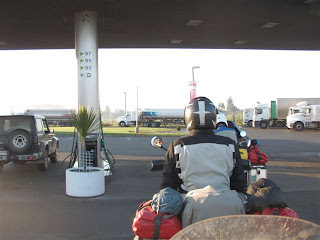
But having arrived early, we were able to pop into the car line and get fuel immediately. There was a great deal of road damage, but with our motorcycles we could often get by where others could not.

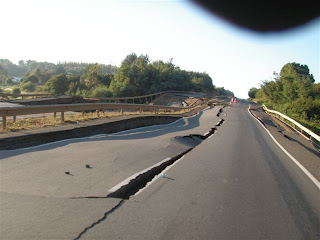
All of the concrete bridges we saw had some sort of damage. Some had fallen completely, and others had crumpled expansion joints; in those cases, the bridge stayed in place, resting on the abutment, but the ground had moved, crushing the expansion joints.
This poor truck driver was passing under a pedestrian bridge as the quake was occurring. He felt a fluttering and thought it was the wind, until the bridge struck the top of his vehicle. He survived without a scratch:

Bridges like this railroad bridge, made of steel, are more complicated to engineer and build, but the steel gives them ductility that provides a lot of latitude when the ground is moving around it:
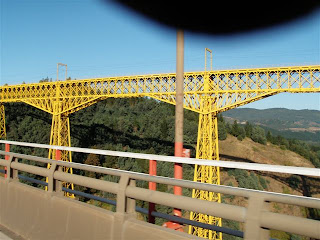
Astonished by the effects of the earthquake, it was difficult to concentrate on our surroundings. I tried to take moments to notice that we were traveling through beautiful country with Ohio-sized large farms. Elsewhere, the topography looked much like New Hampshire, hilly with lots of trees – the country is indeed beautiful.
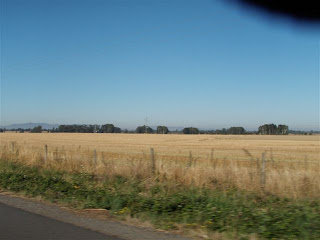
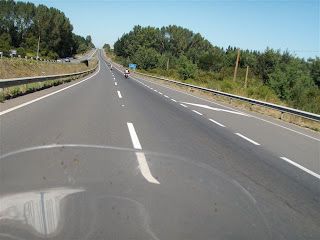
We arrived in Osorno, 100 kilometers from the Argentine border, and had a moment to reflect on our experience. Our challenges are not yet over—finding gasoline is the major concern. The gas stations cannot get gasoline because the trucks do not have the fuel to get the trucks south.
On a per capita basis, Chile is the richest country in South America and has the technology and the means to clean up this mess. Nicaragua, on the other hand, is still struggling to fix the problems from their earthquake a number of years ago.
At our hotel in Osorno, I ran into several doctors with associations with the Cleveland Clinic: Dr. James Lehman, an 83 year-old plastic surgeon from Akron Children’s and a close friend of Dr. Frank Papay’s; and C.J. Langevin, a plastic surgeon Fellow who worked with Dr. Frank Papay and Dr. Walter Maurer – another motorcycle fanatic. They spent a two-week stint in Concepcion and told us a harrowing story about crossing the Bio-Bio bridge moments before it collapsed and subsequently sleeping bundled on the street for two nights for fear of building collapse.
We are wondering what we should do to commemorate this extraordinary event—our first thought was to get a tattoo (we are still determining what it should say). Our other thought was to get earrings. We picked up some of the glass from the fancy chandelier in our hotel— wouldn’t that make a nice earring (perhaps Heather Moore could carve something on it to immortalize this event?).
Tomorrow we will cross back into Argentina.
We hung out with several cops during the day – here is the commander of the motorcycle police in Santiago, mock-arresting Roger.
I was able to pick up all the equipment I needed to repair various items: my POV camera, the sole of my motorcycle boot, and various nuts and bolts that had fallen off my bike.
We toured the city, which was primarily filled with low-rise buildings. . .
. . .with a smattering of high rises in the downtown area. This building is next to our hotel in the center of the city (note that the road through the center of the city is a parkway with 5 lanes in each direction, which comes in handy during earthquakes):
The city center had shops designed for nearly everyone—this one would be a particular favorite of my daughters and anyone with a shoe fetish:
EARTHQUAKE
February 27
We went to bed on Friday night with a plan to wake up early and beat the traffic – meeting for breakfast at 7:00 a.m. and “clutches out” by 7:30 a.m.
I slept fitfully and at 3:30 a.m. awoke to a creaking noise. I tried to get out of bed but was unable to stand and subsequently fell and conked my head on a piece of furniture. I then realized that we were experiencing a quake. We were on the 20th floor of the Crown Plaza hotel, a new modern hotel in downtown Santiago. (I previously experienced another earthquake at a downtown hotel in Tokyo and was rather embarrassed when I dashed into the hall in my bathrobe, only to discover that no one else was slightly concerned.) I briefly considered leaving the hotel but remembered how foolish I felt in Tokyo.
I looked out over the city and the lights were still on and dazzling. But then suddenly all of the lights of the city went out at once.
The oscillation of the building had an abnormal feeling, not like the mostly steady motion you feel in a sailboat in rough seas. This motion was jerky and non-rhythmic, erratic and discontinuous. I was amazed that this largely concrete building was able to survive the whiplashing effect compounded by the building’s height.
Vincent banged on my door, dressed ready to ride, and said we should head downstairs immediately – all three of us initially said no, but we eventually joined him downstairs. This required running down twenty stories in the concrete inner stairway. (The electricity was off and of course the elevators weren’t working—although I cannot imagine anyone would be stupid enough to actually take the elevators).
As we got nearer to the ground floor, cracks in the walls and separation in the concrete floors became visible:
We passed through areas filled with shattered glass. The hotel attendants were coaxing everyone to move quickly past these hazards:
As we exited the hotel, the street scene before us was a mix of revelers and disgusted hotel guests. . .
. . .including this man in his long underwear:
The hotel staff was extraordinary—they raced around handing out robes for those caught unawares and scantily-clad:
By chance, I talked with a biologist who was knowledgeable about earthquakes and he estimated that we had just experienced about a 6 on the Richter scale. He mentioned that the aftershocks were always significantly less than the initial shock, generally 3-10 times less in absolute severity.
So I decided to return my room and headed through the lobby where, as you would expect, informality was evident:
Vincent was napping on a couch . . .
. . . and a variety of others were hiding their scantily-clad bodies under hotel robes.
I trudged up the twenty floors and arrived in my room. I hung the hair dryer from the bathroom sink to watch it sway during the aftershocks – during one aftershock, the arc of the sway reached about five inches:
This leads me to believe that the arc of the sway during the main earthquake would probably have been around two feet.
We got our stuff together, carried it down the twenty floors and headed out of town. We saw very little damage in Santiago itself, although we didn’t go into the areas of old construction where we subsequently heard most of the damage had occurred.
As we drove through downtown, things looked relatively normal, but as we got a bit further out of town we ran into large traffic jams – some were miles long:
To get away from the highway and the traffic jams, we went over land and took dirt roads into the mountains and away from the cities. We were fortunate that our GPS systems contain full maps of Chile and show the secondary roads as well as primary ones.
The road was extremely dusty, and large boulders were frequently in our path, obscured by the dust we kicked up.
As we neared Los Angeles (115 kilometers southeast of Concepcion), there were mile-long lines for gasoline. . .
. . .downed bridges. . .
. . .heaving roads. . .
. . .and a spot where one lane of the road had disappeared into a ten-foot trench.
We passed a large distribution center that was ablaze, with no fire department in sight:
Most of the hotels in the small town of Los Angeles had been damaged and were not open for business. We found a place to stay that looked like it may have been used as a bordello. We scrounged some food at a convenience store, buying all of their canned sardines and two bottles of wine, and had an excellent dinner.
Sunday, February 28
The next morning, we got up early and passed a huge line of trucks waiting for fuel:
But having arrived early, we were able to pop into the car line and get fuel immediately. There was a great deal of road damage, but with our motorcycles we could often get by where others could not.
All of the concrete bridges we saw had some sort of damage. Some had fallen completely, and others had crumpled expansion joints; in those cases, the bridge stayed in place, resting on the abutment, but the ground had moved, crushing the expansion joints.
This poor truck driver was passing under a pedestrian bridge as the quake was occurring. He felt a fluttering and thought it was the wind, until the bridge struck the top of his vehicle. He survived without a scratch:
Bridges like this railroad bridge, made of steel, are more complicated to engineer and build, but the steel gives them ductility that provides a lot of latitude when the ground is moving around it:
Astonished by the effects of the earthquake, it was difficult to concentrate on our surroundings. I tried to take moments to notice that we were traveling through beautiful country with Ohio-sized large farms. Elsewhere, the topography looked much like New Hampshire, hilly with lots of trees – the country is indeed beautiful.
We arrived in Osorno, 100 kilometers from the Argentine border, and had a moment to reflect on our experience. Our challenges are not yet over—finding gasoline is the major concern. The gas stations cannot get gasoline because the trucks do not have the fuel to get the trucks south.
On a per capita basis, Chile is the richest country in South America and has the technology and the means to clean up this mess. Nicaragua, on the other hand, is still struggling to fix the problems from their earthquake a number of years ago.
At our hotel in Osorno, I ran into several doctors with associations with the Cleveland Clinic: Dr. James Lehman, an 83 year-old plastic surgeon from Akron Children’s and a close friend of Dr. Frank Papay’s; and C.J. Langevin, a plastic surgeon Fellow who worked with Dr. Frank Papay and Dr. Walter Maurer – another motorcycle fanatic. They spent a two-week stint in Concepcion and told us a harrowing story about crossing the Bio-Bio bridge moments before it collapsed and subsequently sleeping bundled on the street for two nights for fear of building collapse.
We are wondering what we should do to commemorate this extraordinary event—our first thought was to get a tattoo (we are still determining what it should say). Our other thought was to get earrings. We picked up some of the glass from the fancy chandelier in our hotel— wouldn’t that make a nice earring (perhaps Heather Moore could carve something on it to immortalize this event?).
Tomorrow we will cross back into Argentina.
Back to Top


Add A Comment